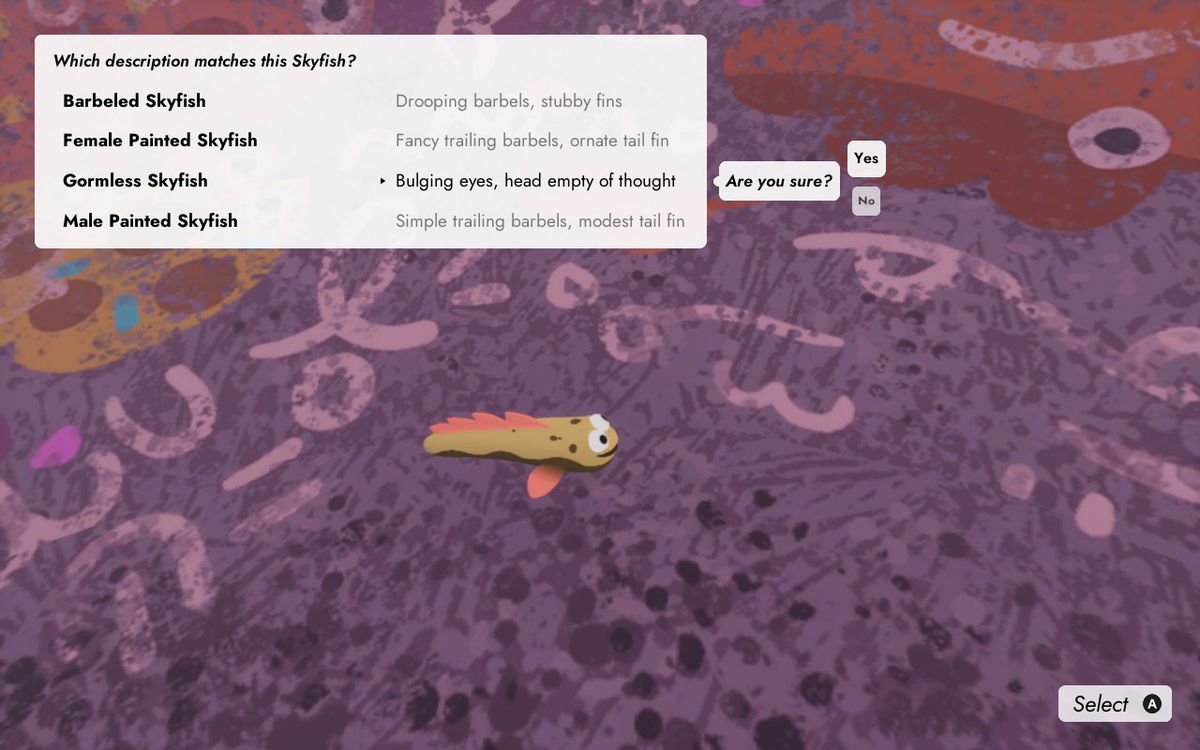As a child, I owned a little encyclopedia of Pokémon. Each page of this handbook contained an entry for one of the many fictional creatures and shared information about its personality, type, and unique characteristics. I pored over its many factoids and scribbled them on lined binder paper with my number two pencil. In the early days, I gravitated to Pokémon games not just because of the combat, but because I liked to learn about the series’ many creatures. Now, by playing Flock, I’ve found a game that really scratches that itch.
The premise of Flock is relatively simple: I play as a person who rides a giant bird. This colorful, bulbous bird allows me to glide around a floating sky island, and use its chirping to charm the local critters. There’s just one problem: The whistles that train the bird to learn the calls of each creature — and unlock my bird’s ability to recruit them — were stolen. Now it’s up to me to explore each biome and find the whistles that will allow me to befriend the local fauna and collect more information on the critters.
Developers Hollow Ponds and Richard Hogg bring to life a vibrant, almost cartoony world; the art style pairs brightly-colored, low-poly character models with environments illustrated in patterned brush strokes. The graphics lend a sense of levity and whimsicality to the world, creating the perfect setting for Flock’s many creatures and curiosities. As I dart around the biomes, I see floating creatures that take inspiration from all ends of the animal kingdom like adorable bug-eyed fireflies, creatures that look like porpoises without dorsal fins and tails, and others that resemble glorified larvae.

Becoming an expert naturalist of all these silly guys has been surprisingly fun. When I see a critter for the first time, I can identify which family it belongs to based on short, in-game descriptions — unless it’s the first time I’m observing a creature in a particular family. In that situation, I need to figure out which species it is via a little text quiz.
Some identifications are easy as pie. Creatures in the Cosmets family, for example, all look super similar and have curved boomerang-esque bodies; from there, I can easily pick out each individual species in the family because of the bold and varying patterns on their bodies. However, some identifications require a bit more thought. I struggled with the Male Painted Skyfish because of the difference in barbels between members of its family.
Once I find the corresponding whistle for a family of creatures, the bird I ride can partake in a flamboyant wooing ritual. In it, I play a little minigame where I navigate my bird towards the other creature as it flies around; I then try my best to line up these brackets that pop up on the screen that indicate if the whistle’s call will effectively charm the creature. The trick is to get the distance between the creature and my character right as I fire off a bird call. It looks silly, but it never feels awkward, and it’s just the sort of interaction I’d want to see narrated by David Attenborough.

Even with all the quizzes and learning, Flock makes for a laid-back time. The game doesn’t punish you all that much for getting the answers wrong, and the gameplay reminds me of Abzu or even Journey, where the movement has a smooth, flowing feeling to it. It can be hard to find new creatures, but it’s fun gliding around as you look for cool-looking guys. (This might not be here nor there, but I also do believe the developers have stumbled upon what might be the best game of all time for weed-enjoyers.)
Even with its many goofball moments, Flock brings a necessary flourish to a creature-collecting game. Before the game asks you to specify the family and species based on brief text descriptions, you can watch the creature in the wild. This is important because identifying information might not be visual, but will instead hinge on the habitat you find the creature in, its peculiar flying pattern, or another identifying behavior. Like birdwatching, the game incentivizes each player to stop and just notice the different characteristics of the animals. Once I’ve identified a creature, I can seek out the local researcher to teach me more about it — thus solidifying my naturalist instincts.

The simple act of stopping to observe, and then thinking somewhat critically about the creature, is what makes Flock so special to me. When playing, I wasn’t fighting these creatures or going up to them and assaulting them like I would in a Pokémon game. Instead, I was finding a way to learn about them, and only then would they glide around and vibe with me. Equal parts whimsical and thoughtful, Flock is a must-play for anyone who loves creatures, being a naturalist, or in my case, collecting fun little guys.
Flock was released July 16 on PlayStation 4, PlayStation 5, Windows PC, Xbox One, and Xbox Series X. The game was reviewed on a Steam Deck using a download code provided by Annapurna Interactive. Vox Media has affiliate partnerships. These do not influence editorial content, though Vox Media may earn commissions for products purchased via affiliate links. You can find additional information about Polygon’s ethics policy here.